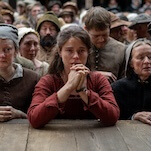Noel Murray, who's thrown away all his jewel cases and put all his now-plastic-sleeved CDs in a file cabinet, responds:
First of all, Ken, you've got to relax. There's no way you're ever going to take it all in, because they keep making more. This is how pop scholarship works: You start with a canon—anyone's canon will do—and familiarize yourself with some of the various rock subgenres' acknowledged classics. Approach them with enthusiasm and an open mind. Just because you don't "get" Trout Mask Replica right away doesn't mean that thousands of rock critics are wrong. It just means your taste hasn't matured enough, or it simply doesn't run toward the avant-blues bleatings of Captain Beefheart. Either try harder to appreciate it, or accept that it isn't for you, and move on.
Once you get past the canon, explore deeper into the subgenres you like, developing some specialties. You may not be able to know everything about everything, but it isn't so hard to become a semi-expert on, say, Afrobeat or sunshine pop. And for heaven's sake, don't be afraid of greatest-hits albums. Yes, some musicians can only be fully appreciated via start-to-finish exploration of their LPs. But others made great pop singles almost exclusively, while still others have such a deep catalog that a decent single- or double-disc survey is the best place to start. Better to listen to compilations of prolific artists than to get only one or two of their albums and miss the full scope of the oeuvre.
And what's that last thing? Do CD-Rs count? Well, what do you want to be, Ken, a critic or a collector? There's nothing wrong with being the latter—we disciples do like to keep our fetish objects around—but in the era of the iPod, clinging to an anal attitude towards CD storage is a losing proposition. Increasingly, once I get three or four CDs by a band I only half-like, I reduce them to a single disc and dispense with the leftovers. Saves space, saves time. And if I find I've trashed a song that I later discover I like, there's always iTunes and eMusic and the like for retrieval. But if the song is gone forever, so be it. Like I said before, there's more music coming tomorrow. And the day after. And so on.
Jad
That isn't actually a question, Jad, but Donna Bowman answers it anyway:
Those two hosts were Tim Conway, Jr. (aren't you glad there's a Tim Conway, Jr.?) and George McGrath, playing Siskel-and-Ebert-style critics disagreeing about the merits of TV parodies like The Gigantic Herman's Playground and The Valerie Harper Only Show. And the show was On The Television, Nick At Nite's first original series, which ran twice a week for 40 episodes in 1990-1991. "Clips" from the fictional TV shows being reviewed featured many up-and-coming comedians of the day, including Lisa Kudrow, Kathy Griffin, and Julia Sweeney. And other better-known personalities—Phil Hartman, Avery Schreiber, Elvira, and Brady Bunch grads Christopher Knight and Eve Plumb—made guest appearances.
On The Television had its genesis in an April Fool's Day special, and its humor leaned toward the bizarre, for the time. It's never been collected or re-aired, supposedly due to residuals owed its principals by the bankrupt production company. If those issues could be worked out, we're willing to bet that there would be enough nostalgic, slightly damaged former tweeners out there to support a DVD release. Meanwhile, if anyone still has some episodes on tape, would you digitize them and put them up on YouTube tout suite? What's the point of the Internet, otherwise?
Why We Live At The B.O.
Why is the popularity of films based solely on box-office receipts rather than a more meaningful gauge, like the total number of tickets sold or the number of screening theaters? Bestseller lists for books and music albums are based on the number of units sold, rather than how much lucre they've generated for their parent companies. Using revenue as an indicator for movie popularity seems not only aggressively venal, but unreliable and devoid of historical context due to inflated ticket prices.
Justin Zimmerman
Number-crunching Noel Murray responds:
This drives me nuts too, Justin, because it makes "box-office champs" out of movies that will never be as beloved as some of the real classics. I've argued this point before with friends of mine who prefer the monetary method of movie-ranking, and they say that finding out how much a movie made satisfies their curiosity about the business side of cinema. If they know the budget, and how much a movie made, they can know how successful it is. Except that we don't know the budget, really. Studios and media types toss numbers around, but they rarely agree—even discounting the cost of prints and advertising that no one ever includes in the final figure. So what's left is a giant game of "watch the money," which can be entertaining, but tells us nothing about the relative popularity of movies across time.
Why is it done this way? Tradition—one that dates back to the early days of Hollywood, when citing how much a movie cost and how much it made was all part of the glamour. Hollywood doesn't just sell entertainment; it sells dreams of opulence. Phrases like "$60 million opening weekend" feed those dreams.
Who You Gonna Call Yet Again?
I am trying to remember the name and details of a live-action show from around the mid-'70s. There was a team of detectives or crime-solvers that included a gorilla as one of their coworkers. They would receive clues which would then self-destruct (usually in someone's face) after playing. None of my friends or coworkers knows what I'm talking about. Did such a show exist? Thanks!
Susan
This might be a very simple question, but were there two Ghostbuster cartoons on? I remember the official one, which had the voice talents of Arsenio Hall and the guy who did the old Garfield cartoons, but one of my friends swears up and down that there was a second cartoon too. This one had the name Ghost Busters, and had a flying car and, God help us all, a monkey. Were there two cartoons? And if there were, what's the story behind it?
Joe Cormack
What was the deal with the fact that there were two Ghostbusters cartoons, Ghostbusters and The Real Ghostbusters? Please do not misconstrue this question as snitching.
Jacob
Tasha Robinson has no idea what to make of that "snitching" comment, but she forges ahead anyway:
I was really just going to let this one go, guys, since there's a wealth of material online about the iterations of Ghostbusters, for those interested enough to go looking. And yet we get this question pretty regularly, so clearly the public has a yen to know. Besides, I recently saw a trailer that brought the whole subject back to me. (More on that below.) So here we go:
Yes, there were multiple Ghostbusters cartoons, but the story goes back a ways. In 1975, Norm Prescott and Lou Scheimer's production company Filmation launched a slapsticky live-action show called The Ghost Busters, in which two dudes—Kong (Forrest Tucker) and Spencer (Larry Storch)—and their gorilla companion Tracy (Bob Burns) solved wacky ghost-related mysteries. This is likely the show you were thinking of, Susan: It did in fact feature a running gag where Spencer, Tracy, and Kong picked up the recorded details of their latest ghost-hunting assignment, encased in an item that would promptly explode in their faces, in a parody of Mission Impossible's self-destructing assignment briefings.
Incidentally, it may seem a little backward that Kong is one of the humans, while Spencer and Tracy (whose names were doubtless inspired by actor Spencer Tracy) are an ape-and-man duo, but you can watch the opening credits/series trailer for proof. A lot of the old Filmation series have been hitting DVD lately—including The Ghost Busters, Susan, if you want to relive the show—and they generally include trailer galleries featuring the opening credits of other new-to-DVD Filmation series. Which is how I recently came to see the opening credits of The Ghost Busters for the first time. I thought it looked so hilariously clumsy and tacky, even compared with all the spin-offs that followed, that I just had to write something about it.
Looking back for a moment… Wikipedia claims that The Ghost Busters was inspired by an earlier '70s film, but that's an unsourced statement, and I haven't been able to find any evidence that such a film existed. Though back in the '40s and '50s, the Bowery Boys comedy team did a series of mock horror films, including Spook Busters, Spook Chasers, and Ghost Chasers, that might have been an influence; Spook Busters, the first of the batch, was made under the working title Ghost Busters, and it had an escaped gorilla prominently running around. So it might have helped inspire the 1975 show. But that's just conjecture on my part.
Back to Jacob and Joe's actual questions in a minute. First, some more background. In 1984, Ivan Reitman directed a film called Ghostbusters (you know, the one with Bill Murray, Harold Ramis, and Dan Aykroyd), which had nothing to do with the 1975 TV show, except in that it featured people who used scientific equipment to capture ghosts. Unfortunately, Filmation still had the legal rights to the title, and it sued Reitman's production company, Columbia Pictures. Columbia settled the lawsuit by paying Filmation an undisclosed fee for a non-exclusive license, meaning that both studios still had the right to use the Ghostbusters title.
So when Reitman's film became a huge hit, Filmation launched a Ghostbusters series to take advantage of the film's fandom. Remember that it had the rights to the title, but not to any of the material from the Reitman movie. So it created an animated spin-off of the old 1975 live-action show. The 1986 Filmation cartoon once again featured Spencer, Tracy, and Kong bouncing around in an old jalopy—though yes, it could convert into a flying machine—and fighting spooks and monsters led by a sort of evil wizard robot thing named Prime Evil. You can see the opening credits here.
The same year, Columbia launched its own animated spin-off of the Reitman film, featuring the characters from the movie. This was the version that featured Arsenio Hall (playing Winston Zeddmore, the "fourth ghostbuster" role Ernie Hudson played in the Reitman movie) and "the guy who did the old Garfield cartoons," a.k.a. Lorenzo Music (playing Peter Venkman, the Bill Murray role from the film). Here are the opening credits of that cartoon, for comparison.
Of course, this meant there were two cartoons under the same name on television at the same time. Sort of. Columbia's version, on ABC, was quickly relabeled The Real Ghostbusters, to emphasize its connection to the movie and downplay the other series. (DVDs of a few of the episodes are available under this title; most of the series has never been released on home video, but it's enjoyed a healthy life in cable syndication on the likes of Nickelodeon, Fox Family, and USA.) Filmation's version, on CBS, responded by changing its cartoon's name to The Original Ghostbusters, though the DVD sets are branded as Filmation's Ghostbusters. (Volume one came out in February; volume two is due in summer. Together, they'll contain all 65 episodes.) There's a ton of interesting trivia on all of the above series—The Ghost Busters, The Real Ghostbusters, and The Original Ghostbusters—floating around on animation sites and Wikipedia, though I notice that a lot of it is contradictory from one page to the next, especially on the timeline between the two cartoons, and on their creators' intentions.
At any rate, The Real Ghostbusters indisputably won out in the end… The Original Ghostbusters only lasted a few years, while The Real Ghostbusters ran to 140 episodes and stayed on the air until 1991, albeit with yet another name change, to Slimer! And The Real Ghostbusters in 1988. (Here's the revamped version of the intro sequence, now 20 times more annoying.
But hey, Joe and Jacob, when you were asking how there came to be two Ghostbusters cartoon series, you overlooked something… there was a third one. Extreme Ghostbusters, a Real Ghostbusters spin-off in which Egon Spengler rounds up a new team of hip young kids to take over the whole ghost-busting franchise, debuted in 1997, and ran to at least 40 episodes before it was cancelled. A few episodes came out on VHS, though they're out of print now. Here's one last intro sequence. And with that, hopefully we can put this whole question to rest for a while.
Next week: Could a computer pick the next pop hit? Send your questions to [email protected].








































